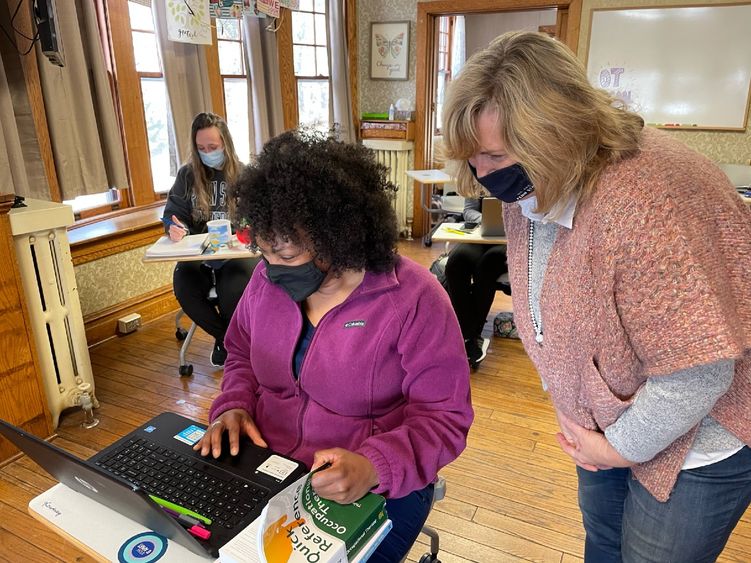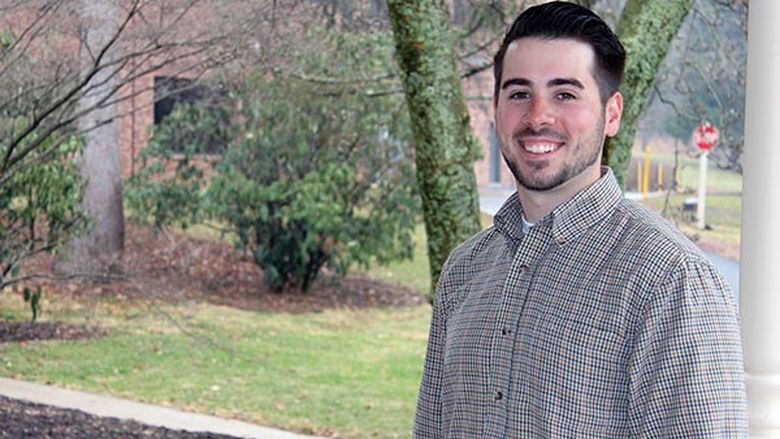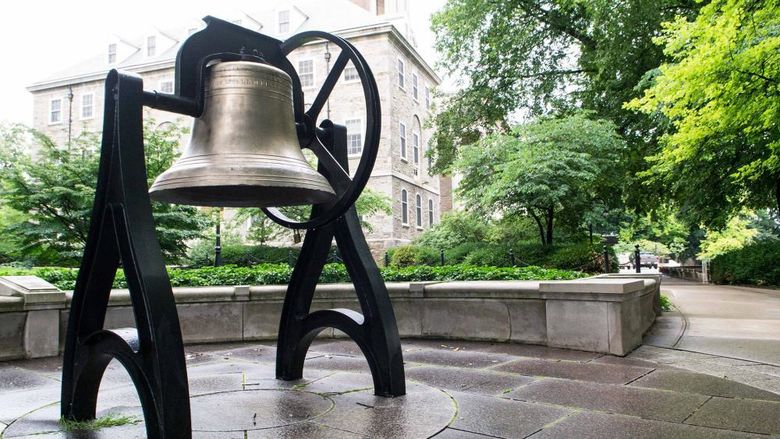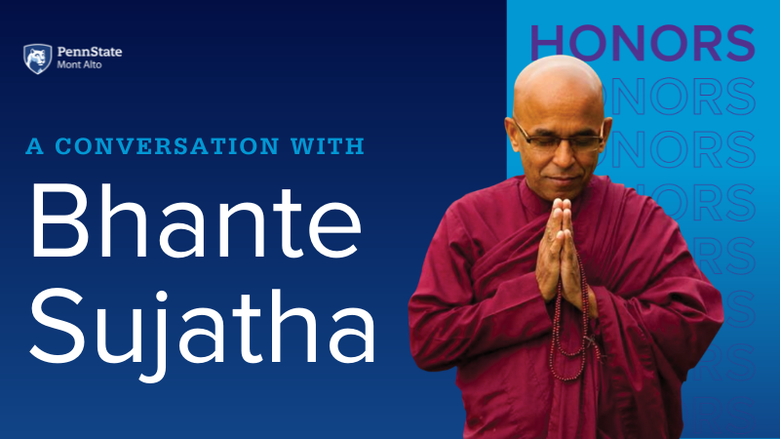
Angela Hissong, professor-in-charge of the Occupational Therapy Assistant program at Mont Alto, talks with a student during a class exercise.
MONT ALTO, Pa. — For the last three decades, the Occupational Therapy Assistant program at Penn State Mont Alto has educated and developed about 750 highly qualified, caring OTAs, while becoming a part of the fabric of Franklin County.
Since 1991, OTA faculty have focused on supplementing classroom learning with community outreach and engagement that help students form strong relationships with residents of all ages in the area.
They create mind, body and spirit wellness experiences for the residents of Trinity House, which provides affordable residential options for senior citizens. On the other end of the life spectrum, students in the program take part in faculty-guided fieldwork with those ages 6 weeks to 12 years at Noah’s Ark Child Care Center. They interact with and develop activities that focus on motor, sensory, cognitive and psychosocial aspects of play.
Out in the community, those in the OTA program raise money for Penn State THON, the largest student-run philanthropy in the world, through the Lavender for Lil’ Lions project, making and selling car and home fresheners using organic lavender and muslin bags. Students also have taken part in an event called "Night to Shine," creating a prom experience for those ages 14 and older who have special needs.
The diverse hands-on options prepare them for the myriad jobs that await those who earn the associate in science in occupational therapy.
“We help people with everyday occupations across the lifespan,” said Angela N. Hissong, director of the OTA program at Mont Alto and professor-in-charge of OTA programs.
For instance, a 6-year-old’s job is to play and go to school, so OTAs can help a child that age with cerebral palsy successfully do both, Hissong explained. An older person who suffered a stroke or fractured a hip can resume activities such as cooking, grocery shopping and being actively involved in their grandchildren’s lives with the assistance of an OTA.
“Occupational therapy is more than just playing with kids or working in a nursing home,” said
Anna Angle, a 2013 Penn State Mont Alto alumna, serves as OT manager at the Pediatric Movement Center in Hagerstown, Maryland. “Occupational therapy is assisting an individual — whether pediatric, geriatric or somewhere in between — to be able to obtain the highest quality of independence and functional ability that we can in that period of the individual's life. We address what is meaningful to each individual and make that our priority.”
As the name of the profession suggests, occupational therapy also can help people get back to work after an injury or illness. The field requires an ability to understand the full scope of a patient’s needs.
“The cool thing about OT in general is we’re trained to look at a holistic perspective,” said Stephanie White, a 1996 graduate of the OTA program at Penn State Mont Alto and safety officer and director of rehabilitation services at Fulton County Medical Center. “OTs just go above and beyond. We don’t give up easily. We have the skills and the heart.”
A program evolves
That wide-ranging perspective has not changed in the OTA program, and some subject matter has been consistent over the last three decades. Therapeutic use of self is at the heart of OT education and practice, and the three areas of primary education to practice are still children and youth, physical health, and behavioral and mental health. Engagement in community outreach and service is a thread woven into each semester, as well as intraprofessional collaboration among the cohorts.
Hissong said teaching methods are still grounded in the belief that occupations may be used for health promotion and wellness, remediation or restoration, health maintenance, disease and injury prevention, and compensation/adaptation.
Much has transformed, too.
When the program started in 1991, it lasted four semesters, but as health care demands changed, so did the teaching-learning expectations of the program. In 2004, the OTA coursework was spread over five semesters, or two and a half years. Ten years later, five credits were added to the curriculum to provide fieldwork education, teach clinical reasoning, and prepare students to take on more leadership roles in medical-based and community health-related systems upon completion of the program.
The occupational therapy practice framework has gone through six reiterations in the past 30 years and the Accreditation Council for Occupational Therapy Education’s standards are updated every five, so the faculty regularly does a full curriculum review. Those reviews lead to updates on methods, modality and teaching-learning strategies that align with contemporary OT practice.
When the COVID-19 pandemic hit in March 2020, approaches to teaching evolved even more. Hands-on training was replaced with virtual lessons, turning instructors into tele-educators and tele-therapists.
“Most assuredly, our practitioner skills of helping students (and ourselves) with stress management, confidence with technology, and exploring innovative ways to practice occupational therapy were paramount this past year,” Hissong said.
“In this past year, occupational therapy has changed drastically in the way we treat,” Angle said. “Since the pandemic, we have had to adjust to a lot of telehealth sessions versus in-person treatments. This has been a challenge, learning this new way of therapy, but is something that I foresee in the future being utilized frequently, especially in the pediatric setting.”
Justin Freeman, who earned his associate of science in occupational therapy in December 2018 from Penn State Mont Alto and is now an OTA at the Pediatric Movement Center, acknowledged there was a steep learning curve in telehealth.
“However, I feel it has developed a closer relationship with parents/guardians, their children we treat and us as COTAs (certified occupational therapy assistants),” Freeman said. “It has improved parent/guardian involvement through assisting and facilitating activities throughout treatment sessions.”
The leaders of the OTA program will continue to assess and respond to the needs of students and the community and monitor overall health care across the country. As the American Occupational Therapy Association asserts, “Occupational therapy assistants play a key role in every area of practice, as well as emerging opportunities in community settings.”
Creativity and compassion
Hissong joked that there is an “OT gene” because there are some commonalities among OTAs, including creativity, nurturing and encouraging tendencies, and strong organizational skills.
“You just know you want to help people,” she said.
Jaime Schwartz said that occupational therapy assistants take time to get to the heart of the mental, physical and medical needs of patients.
“We’re freer to use those investigative skills,” said Schwartz, who has worked at Fulton County Medical Center since completing the OTA program at Penn State Mont Alto in 2012.
That critical reasoning often leads to taking unusual approaches to maximizing the quality of someone’s life.
Schwartz recalled a patient who had a stroke and fell several times, and her body had lost significant conditioning. She wanted to be able to put a bra on by herself. After trying various methods, Schwartz suggested the woman step into it, which worked.
“Compassion and creativity are really the key to the job,” White said. “We get to know patients at a totally different level.”
“We put ourselves in that person’s body and try to imagine as best we can,” said Amy Varner, who graduated from Mont Alto’s OTA program in 1997 and has worked at Fulton County Medical Center for 26 years.
Hands-on collaboration
The Penn State Mont Alto OTA program has a record of success.
Its students have maintained a 97% pass rate on the National Board of Occupational Therapy Certification exam over the past 30 years. And 96% of students who enrolled in the program completed it, according to recent graduation rates, which are reported over three-year periods.
While the statistics are impressive, what Hissong really loves is the approach taken to educating students to assist patients by promoting health and preventing — or living better with — injury, illness or disability. There is an 18-student maximum in all OTA classes, and a low student-teacher ratio means there are lots of one-on-one experiences, said Hissong, who holds bachelor’s degrees in biology and OT, a master’s degree in special education, and a doctorate of education in lifelong learning and adult education, the latter of which she obtained from Penn State.
Hissong and Olivia Hammond, academic fieldwork coordinator and an assistant professor in the OTA program, are certified yoga instructors, which gives them insight on how to use stress-management techniques in real time with students. Evidence-based research from Penn State and other institutions across the country support the use of mindfulness techniques with college students to decrease stress, enhance self-awareness and focus on learning, Hissong said.
As the students become more comfortable with their inner lives, they will have the chance to acclimate to new physical surroundings on campus.
The top floor of the new Allied Health Building will house the OTA program and faculty offices, plus space for the faculty leading the physical therapist assistant program. The technologically advanced three-level facility will feature an outpatient rehabilitation area, hand clinic, and pediatric and wellness clinic that will double as classrooms. The OTA area also will have a full-sized, open-concept apartment with living room, kitchen, bathroom and bedroom, which will be used to simulate activities of daily living for training purposes.
Parts of the 22,000-square-foot facility will be used by nursing, physical therapy and occupational therapy students to mirror real-life working relationships.
“The hub will encourage interdisciplinary collaboration to promote the best or optimal patient experiences and state-of-the-art health care,” Hammond said.
“Penn State Mont Alto’s OTA program has a contemporary student-centered agenda focused on five curriculum threads: authentic leadership, occupation as the foundation of practice, lifelong learning, everyday mindfulness and therapeutic use of self,” Hissong said. “The bottom line is the OTA faculty at Penn State Mont Alto truly have a love for the profession and for teaching and learning.”
Learn more about the OTA program at Penn State Mont Alto here.





